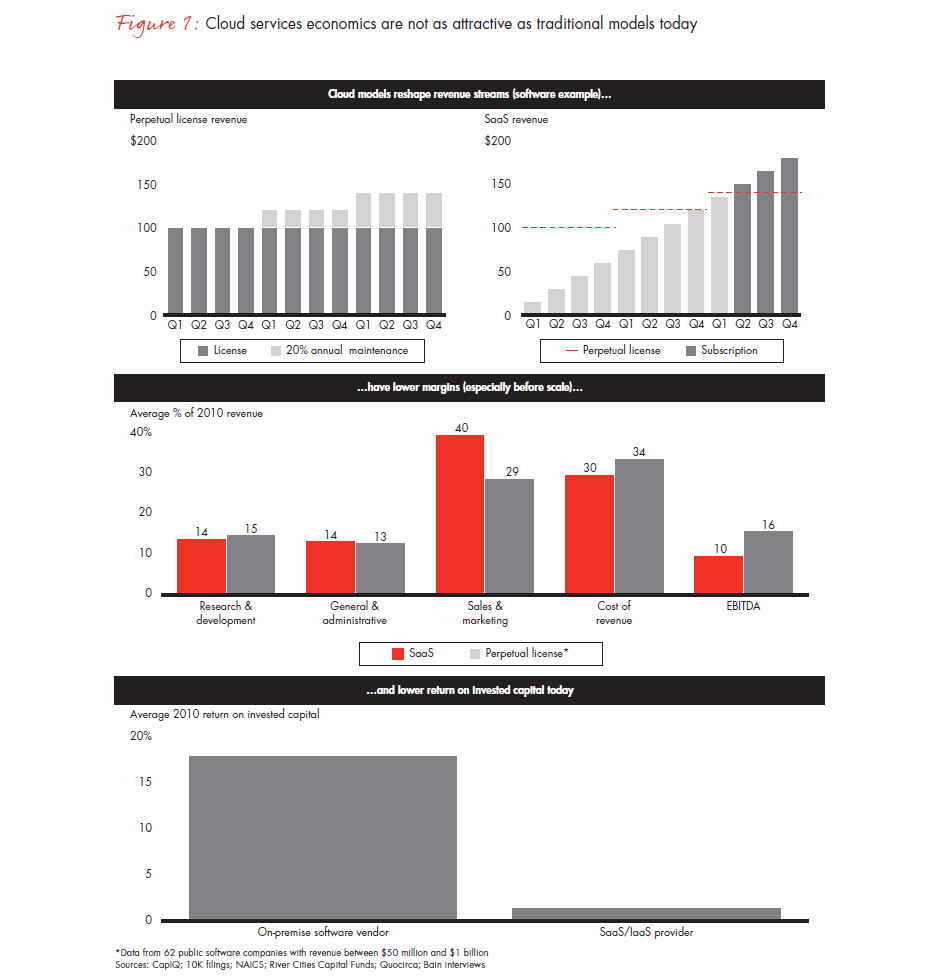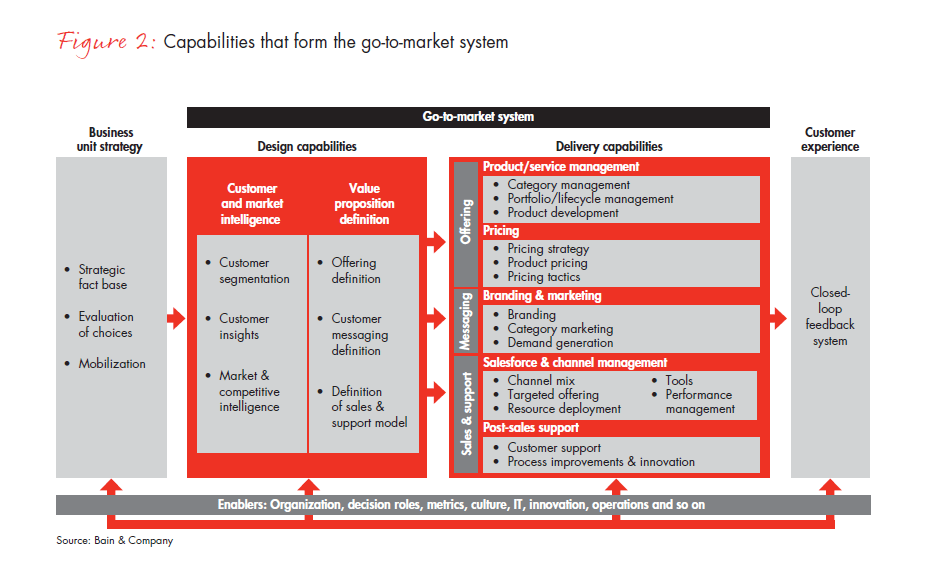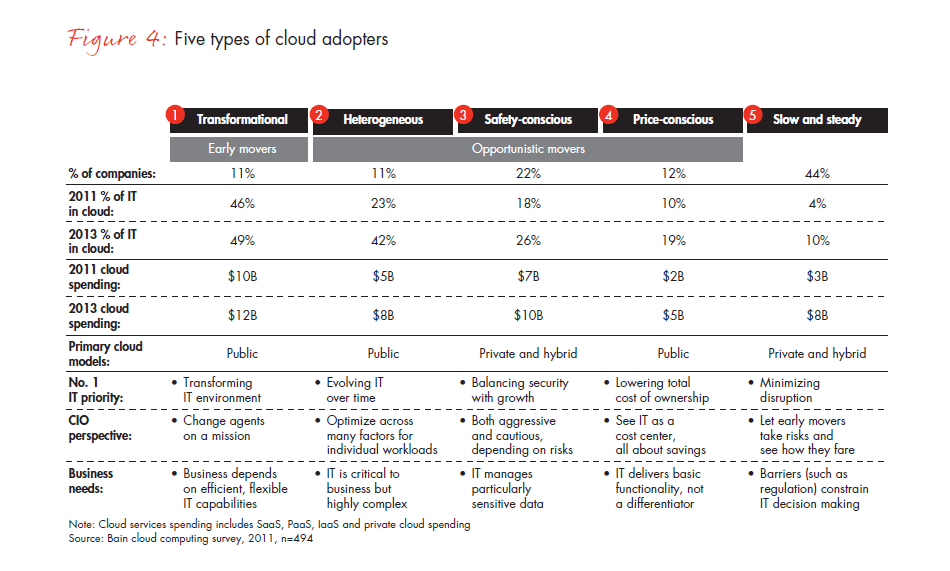Etude
As the market for commercial cloud services reached $27 billion in 2011, many incumbent technology providers stood on the sidelines, hesitant to embrace this opportunity. That means only about 20% of the market for public and private cloud services belongs to incumbents today. It’s still early days, and it’s not certain whether those with the initial lead will continue to win.
Over the past year, hesitancy has given way to urgency, as incumbents have realized that they must invest more in this rapidly growing sector of the market—or else risk being left behind by disruptive forces that are reshaping the technology industry. In the first quarter of 2012, software-as-a-service (SaaS) acquisitions accounted for 16% of all software industry acquisitions, up from 2% two years earlier, according to the Software Equity Group. Despite many deals, only a few incumbents, Intuit and Ariba among them, have transitioned meaningful parts of their businesses to the cloud.
At the same time, early cloud leaders are finding it hard to sustain the rapid growth that supports their high valuations. These companies have invested heavily in innovation to appeal to the next generation of cloud adopters entering the market. Salesforce.com unveiled its Social Enterprise vision, a collection of social, mobile and open cloud solutions. VMware announced its Cloud Infrastructure Suite, a comprehensive set of software to help companies build and manage private clouds. And Amazon Web Services announced 82 new releases in 2011 alone.
The challenge now becomes how to turn all this momentum, innovation and investment into revenue growth and profits. While incumbent providers and early cloud leaders have focused primarily on developing and launching new cloud offerings, their go-to-market systems have fallen behind. Self-service provisioning may have been enough for early adopters, but to win more opportunistic buyers and later adopters, providers will need to adapt their go-to-market systems. In fact, adapting their approach will be at least as important, if not more so, than innovative offerings and high-quality service delivery in determining the winners in this next round of cloud growth.
Adapting go-to-market systems for a cloud-delivered world
It’s not difficult to understand why incumbents have hesitated: Cloud computing represents a fundamental shift in value from providers back to customers. Most incumbent providers sell an offering to accommodate peak capacity. Cloud computing charges customers only for what they use and thereby redistributes the value tied up in unused capacity back to the customer.
Cloud computing also changes the business model. Cloud reshapes revenue and cash flow streams and, at least today, has lower margins and return on invested capital (see Figure 1). Some providers indicate that a cloud customer does not reach profitability until the ninth or tenth month of the relationship. However, over time, the recurring payments associated with cloud computing can exceed what is earned from an on-premise product sale. Getting to that inflection point is the challenge and the opportunity.

Because the selling and marketing costs of cloud models can be higher than those of on-premise models— at least as a percentage of initial revenues—it’s critical to have a high-performing go-to-market system, one that’s focused on sales growth and customer retention. Many providers will need to adapt significant aspects of their go-to-market system, including their offerings, pricing, branding, marketing, salesforce and channel management, service delivery and customer support (see Figure 2).

As providers adapt their go-to-market systems, they will need to focus on four critical capabilities (see Figure 3):
- Focus resources on the right customers
- Develop winning value propositions and price them right
- Profitably identify and acquire new customers
- Cross-sell and up-sell to existing customers

Strategic value: Focus resources on the right customers
The foundation of high-performing go-to-market systems is a focus on the right customers. Providers will need to anticipate where future demand will come from and select and maintain focus on their customers’ sweet spot.
Technology start-ups and Internet-based companies dominated the first round of cloud computing over the past five or six years. Ten percent of customers—companies like Netflix and Zynga that have fully transformed the way IT is deployed and consumed—account for nearly 40% of current cloud services revenue. Three quarters of the current demand for cloud services comes from customers with fewer than 1,000 employees.
Winning early adopters does not always guarantee future success. Over the next few years, 85% of growth in demand for cloud services will come from more opportunistic buyers and later adopters. As cloud computing transitions from early adopters to a broader base of mainstream buyers, providers will see that customer needs are becoming more diverse. We have identified five customer segments, based on how companies are likely to adopt cloud computing in the future (see Figure 4).

Some providers choose to focus on one or two customer segments, while others tailor their capabilities to serve the needs of all five segments. While most executives know the importance of tuning all aspects of the go-to-market system to reach the target customer, it is surprising how frequently providers fail to make the changes necessary to win in the cloud market. In a recent Bain study, 81% of companies agreed that segmentation was critical, yet only 23% successfully applied it.
Intuit is a good example of a provider that chose its target audience carefully. Intuit was an early proponent of cloud services, successfully migrating its desktop software business to a cloud-based model by focusing on the needs of an early adopter customer group: price-conscious small and midsize businesses and consumers. Intuit now has more than 35 million customers using its Connected Service hosted offerings, and in the small business group, cloud offerings accounted for 50% of its revenue in 2011.
SoftLayer, a dedicated web services provider, is another provider that has succeeded by focusing on the needs of Internet-focused small and midsize businesses. It has delighted customers with its ability to deliver fast access and direct control of their infrastructure, giving SoftLayer one of the highest levels of customer advocacy in the industry.
Solution development: Develop winning value propositions and price them right
Successful providers effectively tailor all aspects of their go-to-market system to the customers they are targeting. Some cloud service providers that have taken an early lead may be too confident that their offerings will win the next generation of adopters. Similarly, some incumbent technology providers may assume that their existing customer relationships will eventually translate into leadership in cloud computing, especially with late adopters. Those are risky views on which to pin growth hopes. The demands of a transformational customer—those that were most likely to be early adopters—are quite different from those of more cautious customers.
Amazon Web Services has been the early leader in the market for infrastructure-as-a-service (IaaS), growing objects managed by 200% annually from 2006 to 2011. Initially, Amazon focused on transformational cloud customers like Pinterest, Yelp, Gilt Groupe and Foursquare. Gradually, it has begun to tailor its offerings— including dedicated network connections, virtual private cloud services, database services and partnerships with more than 800 software and services vendors— to appeal to a broader set of customers, in particular enterprise customers in the heterogeneous and safety-conscious cloud customer segments.
Of course, pricing is an essential element of the overall value proposition. Effective pricing enables adoption to the point of critical mass, recognizes segmentation of early adopters compared with mainstream adopters, and adds and communicates value beyond the commodity utility service. It starts with an attractive entry-level offer, often free early on, to overcome barriers to adoption, then advances up through tiers of service and larger bundles. For providers whose customers are developers, such as platform-as-a-service (PaaS) providers, effective pricing may allow them to participate in the potential upside if a developer’s applications are successful, while managing the risk of their pricing not scaling with cost. For example, Salesforce.com’s App- Exchange and Microsoft’s Windows Azure Marketplace offer revenue share pricing models that allow them to participate in the potential upside of applications that are successfully developed and delivered on their platforms.
Customer acquisition: Profitably identify and acquire new customers
Incumbents and early cloud leaders will also need to master at least three new capabilities to sell cloud services profitably: efficiently building and scaling more consultative selling skills, ensuring clear rules of engagement across the salesforce and aligning incentives.
While the first round of transformational cloud customers have had lower relative IT spending than slower-moving enterprise customers, they have also been comfortable with low-cost, self-service provisioning. As new customers enter the market with more traditional IT environments, they will need help navigating the labyrinth of options. Providers will need to equip their sales teams and partners with the knowledge, skills and tools to guide customers in their journey to the cloud. Providers will either need to build or buy those capabilities, or partner with companies that have them—a challenging and costly endeavor.
Providers can ensure their direct, or virtual, organizations follow several tactical actions to deliver consultative selling. The first is to arm the sales team with a short list of questions to prequalify customers rapidly and focus on those with the highest potential (see Figure 5).

With a customer prequalified, the next step is to equip sales teams with easy-to-use tools and training to develop a holistic, multiyear view of the customer’s IT environment and workloads that are relevant to the provider’s offerings and to determine how cloud services compare with other technologies, such as virtualization. Depending on the breadth of offerings, sales reps may need to help customers navigate among dozens or even hundreds of potential cloud migration paths and align the organization around the right one. For large enterprises, that assessment often requires building relationships with not only the CIO and IT department, but also the relevant lines of business, other C-suite roles and functions where interest in cloud is often first generated. For example, with customer relationship management, the focus is on the chief sales officer and the sales organization.
Incumbents, in particular, need to clarify the rules of engagement between sales reps selling traditional, on-premise offerings and those selling cloud solutions. Key questions, such as who owns the customer relationship and whether a sales rep selling cloud can or should be actively selling into an on-premise customer relationship, are essential to answer correctly. Some incumbents are trying to clarify these rules of engagement by creating separate cloud business units. However, that is unlikely to be sufficient and, in some cases, may actually exacerbate the conflicts. Successful providers will need to map out the key selling situations, make the difficult trade-offs at the highest levels of the organization based on strategic goals and then align sales coverage, processes and incentives accordingly. A “let the best salesforce win” approach will likely not drive the optimal strategic and financial outcomes for an incumbent provider.
Aligning incentives for the direct salesforce and channel partners in a cloud-delivered world can also be challenging. Software sales commissions are typically based on the sale of a large up-front purchase, such as a software license fee. But cloud customers pay for the service with small, recurring payments, often with no up-front cost or commitment. Commissions on these cash payments need to be altered in order to compensate sales teams. Sales organizations should base commission structures on the expected value of customer lifetime economics, with accelerated bonuses for committed multiyear contracts, higher-margin services and upfront cash payments by customers. Not surprisingly, the economics of the channel change as well. Since cloud offerings typically provide fewer value-added services opportunities to up-sell, channel partners often demand higher discounts on cloud offerings.
The experiences of the Virtual Computing Environment Co. (VCE), a collaborative venture formed by Cisco and EMC with investments from VMware and Intel, offer an example of the challenges vendors face when compensating the channel for selling cloud solutions. VCE launched in 2009 without a dedicated channel program, and the effectiveness of early efforts was limited by channel partners having to work through multiple programs of individual VCE members. VCE relaunched in 2011 with its own channel program, including custom pricing and training, and that has resulted in faster growth.
One of the greatest fears for incumbent providers is that cloud will not bring in new customers, but instead cannibalize existing customers with lower revenue and margin offerings. Oracle’s acquisition of Taleo and SAP’s acquisition of SuccessFactors, for example, both challenge these providers’ large and profitable on-premise HR management system software businesses. However, if a category is rapidly converting to the cloud, incumbents may have little choice but to participate, regardless of the impact from cannibalization. But incumbent providers can also use cloud computing as an opportunity to break into new markets or to innovate in existing markets. SAP, for instance, may find Ariba simpler to integrate since its offerings are more complementary than competitive to SAP’s current portfolio.
Cisco entered the unified communications space as a disrupter against incumbents like Avaya and Siemens, which have large legacy installed bases. With less incumbency in the voice market, Cisco was able to offer a compelling cloud solution, Cisco Hosted Collaboration Solution, adding revenue that did not cannibalize its existing products. Within its first year Cisco had signed at least 17 telecom carriers, along with others, in its partner network, using its cloud solution to cross-sell networking and server hardware along with collaboration solutions such as WebEx and Jabber.
Loyalty and retention: Cross-sell and up-sell to existing customers
Because the cost of acquisition is higher relative to the smaller recurring cloud revenues and the payoff takes longer—and because it is easier for customers to switch— providers will need to become better at holding on to customers and selling them new services. To accomplish this, cloud service providers rely increasingly on pricing and value-added services, along with building a “sticky” platform (or ecosystem) of products and services that creates more value than the cloud service or application itself.
Providers use pricing tiers to encourage up-sell and increase customer loyalty—like Amazon’s Reserved, On- Demand and Spot Instances—to acquire a larger share of the customer’s IT spending and build long-term relationships. Providers cross-sell value-added services, such as application data or application program interfaces, production service-level agreements for performance enhancement and premium features, to bring in more revenue and profitability.
Since customers can switch more easily from one provider to another in the cloud, it’s more important than ever to develop a sticky platform that demonstrates real and increasing value to customers that stay. For Salesforce.com, the value that developers receive with Force.com may be as much about the thousands of customers connected to the AppExchange Marketplace as the development platform itself. For SAP, the strategic value of acquiring Ariba may be as much about the Ariba Network’s connection to 730,000 global businesses as it is about the cloud applications it brings.
Recognizing this, many incumbents will want to harness their existing customer relationships to make the most of their platforms. For example, Telenor, a leading mobile telecommunications provider, headquartered in Norway, launched its Content Provider Access (CPA) platform for premium mobile services in 2000. CPA enables content providers to deliver content to Telenor’s subscribers under their own brands, billing the subscriber for that content under an attractive revenue sharing model. This has proved very successful in premium mobile services and demonstrates the value that can be unlocked by incumbent providers that tap their installed base.
The future is open
The fundamentals of building and sustaining successful technology companies have not changed with cloud computing. Incumbent technology providers need to adapt their organizations to take advantage of growth opportunities created by the cloud, while managing the risks to legacy revenue and profit pools. Early cloud leaders will need to determine how to sustain their momentum as customers with different needs come off the sidelines. The field is still open, and the winners in round two will be those providers that can meet the needs of the large pool of customers that are only now moving to the cloud.
Michael Heric is a partner with Bain & Company in New York. Dianne Ledingham is a Bain partner in Boston. Stephen Bertrand is a partner in Bain’s London office.